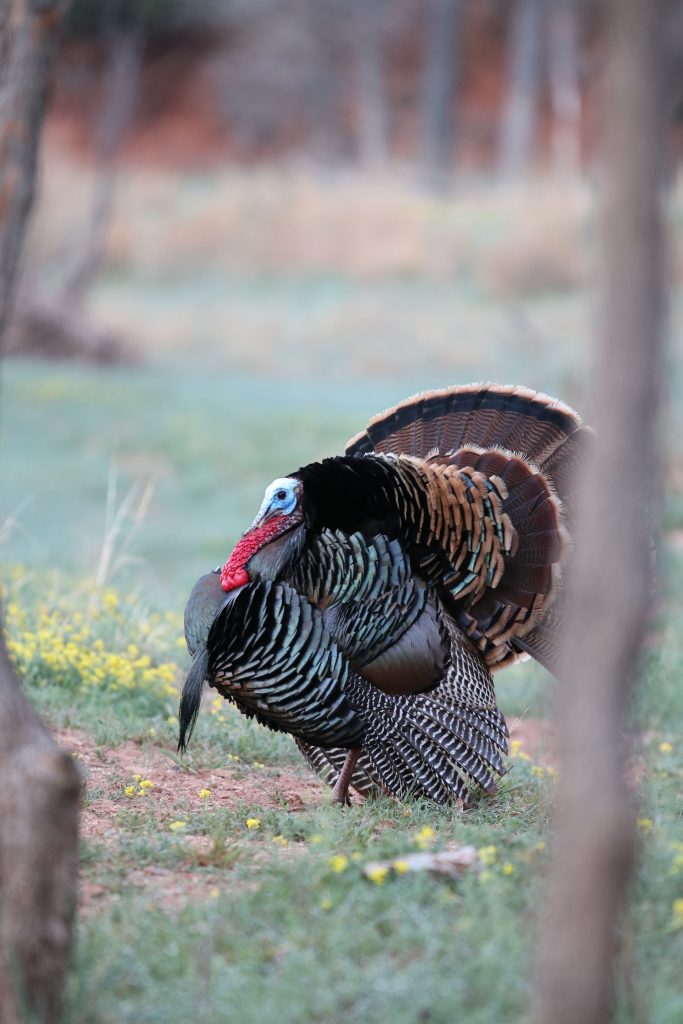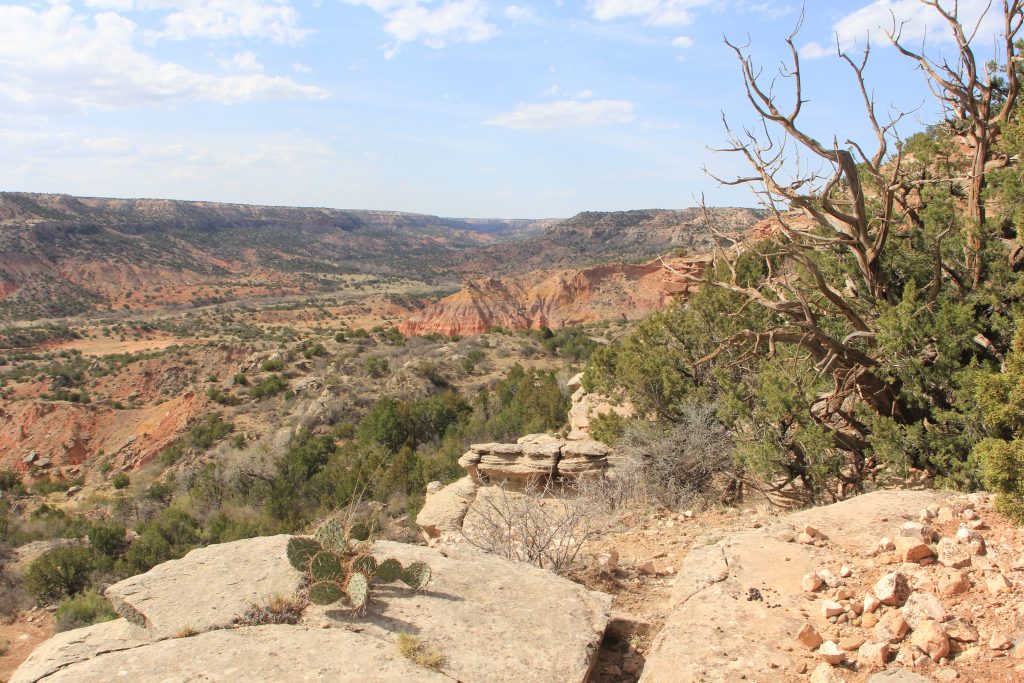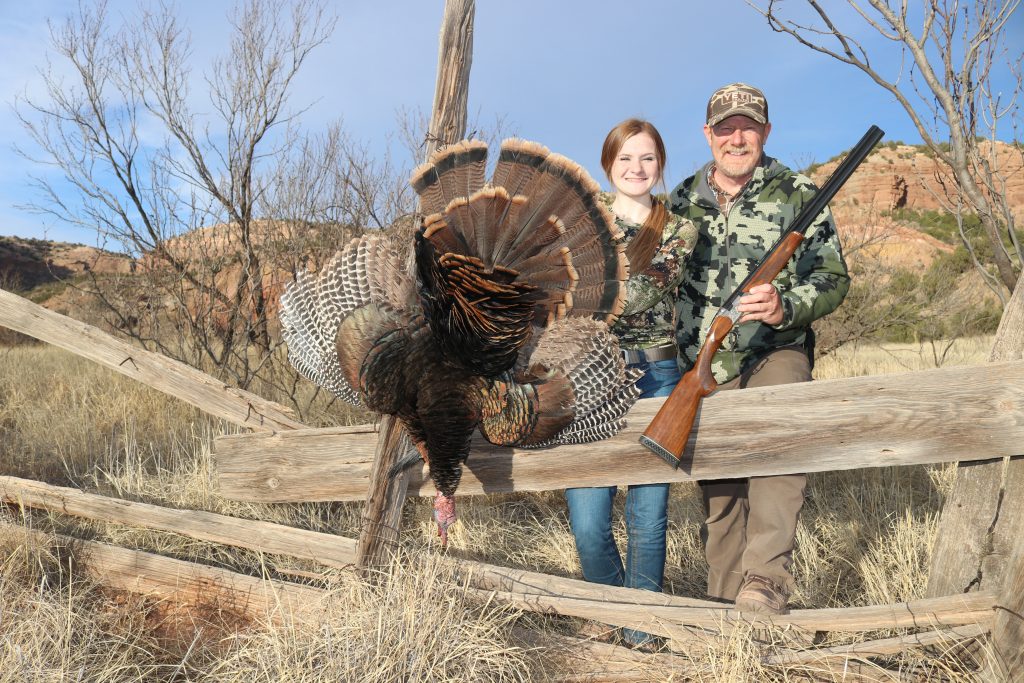Red Rock Gobblers
The Palo Duro Canyon makes a scenic backdrop for an annual father/daughter turkey hunt.
Driving across the dreary plains of the Texas Panhandle, the landscape suddenly drops into a spectacular hole in the ground. The change from milo fields and tumbleweeds to an 800-foot-deep canyon is as subtle as a slap in the face. Every time I drive to the edge, I think what that first encounter must have been like for pioneers traveling in a covered wagon.
Early Spanish explorers named this beautiful oasis Palo Duro Canyon. Translated, it means hardwood, a name for the abundant juniper trees growing along the canyon rim. Indian tribes used the wood to build arrows and bows and hunt game like deer and bison. Today, the canyon is home to a variety of wild game. Big game like mule deer, white-tailed deer, feral hogs and aoudad sheep share the canyon. Smaller game species like coyotes, badgers, foxes, bobcats, cottontail rabbits, scaled quail, bobwhite quail and mourning doves inhabit the rough country. Nongame species like road runners, horned lizards, rattlesnakes and tarantulas remind you that this is very much a desert. Spanning 120 miles long, Palo Duro is the second-largest canyon in the United States. Only the Grand Canyon in Arizona is bigger.
One of Palo Duro’s most revered features is the winding waterway at the bottom of the canyon; the Prairie Dog Town Fork of the Red River. This ribbon of life curves between red canyon walls and under mature cottonwood trees to provide water in an otherwise parched environment. Odd, tilting rock formations on the canyon’s floor resemble the backdrop to a coyote/ roadrunner cartoon. Is this Mars or Texas? If it rains in April, indeed it will bring a blanket of yellow wildflowers in May. It’s here, along the riparian strip of habitat in the red clay, that you find Rio Grande turkeys.
Thanks to the forward-thinking investment of my grandfather, Guy Owens, my family has owned a piece of Palo Duro Canyon since 1948. For a wannabe country kid growing up in Dallas, the annual trip to Rim Ranch was more anticipated than Christmas morning. The ranch provided a young boy with a place to explore. Today, I live on the ranch full-time. I raise chickens and miniature donkeys. I talk to my barn cats more than I talk to people. I’m part of the third generation to care for this land. Hunting turkeys has become an annual tradition for my teenage daughter, Emma, and me.

Spring 2023 Memories
Drought in recent years, and poor poult recruitment, mean the canyon’s turkey population is below average. In lean years we take a maximum of two gobblers off the ranch. The long-term health of the flock is always more important than a quick fix on punching multiple tags. With proper management, hopefully, one day Emma’s kids will hunt turkeys on this same creek.

It was opening day last year, April 1, and I was headed to the creek for an afternoon sit. Preseason scouting revealed a flock of turkeys traveling down a dusty two-track road that paralleled the river. Pitchfork-shaped tracks, spent feathers and wing drag marks in the red dirt confirmed the birds were there often. I set a single hen decoy in front of my ground blind and settled in with an arrow nocked at 3 p.m. The temperature was 72 degrees. It was a fine spring day.
I called every 15 minutes. The turkeys were silent. One hour into my sit, I looked up and saw three gobblers walking in my direction down the creek. They never made a peep, but they were clearly focused on my decoy.
The bird with the biggest body was on the right. He stopped at 14 yards to gawk at the plastic fake. Already at full draw, I purred with my voice to get his head up and alert. The green sight pin steadied, then the arrow was gone. The carbon missile hit the big gobbler in the neck, dropping him instantly. The handsome Texas Rio had an 8-inch beard and 1-inch spurs. As if the day couldn’t get any better, I found two bleached whitetail sheds on my walk to the truck.
Success for Emma
Emma’s gobbler came on the afternoon of April 7. The high temperature was 68 degrees and light south winds made for ideal conditions to hear turkeys talking. On route to sit a blind, we spotted the fanned-up tail of a strutting tom. He was guarding five hens in the shadows of a large cedar tree. We decided they would eventually come by our setup, so we skirted their perimeter and got in the blind.
For two hours we sat. I sent a lonely yelp into the afternoon air every 15 minutes, but it was met with silence each time. The normally loudmouthed toms of this remote river corridor were silent. We decided to get aggressive.
We ditched the blind and climbed a brushy knob to glass the river habitat. Most of the creek bottom was void of birds, but surprisingly, the same fanned-up gobbler and five hens were still under the same cedar tree! They had not moved or made a sound in two hours. The stalk was on.
On our hands and knees, Emma and I crawled through knee-high grass. Sand burrs and prickly pear cactus needles stabbed at our shins and elbows. Slowly, we closed the gap. Finally, we hid behind a bushy cedar tree.
Through the 10X binoculars, I could just see the top of the bronze-colored tail fan of our target. “He’s 25 yards straight ahead. Ease around this cedar, stay low, and aim for his neck. Make sure the hens are out of the way when you shoot,” I whispered to my partner.
Emma sat up on her knees and the flock immediately spotted her movement. The gobbler turned broadside, letting halfway out of his strut. The hens started to putt and head south. When the big gobbler was clear, Emma tugged the trigger. Boom! The hardhit gobbler went straight down with barely a flop. The fancy Beretta Silver Pigeon 20-gauge coupled with Browning TSS ammo is a deadly combination at 26 measured steps.
Emma’s big gobbler had 1-inch spurs and a 9-inch beard. He had the classic tan and copper coloring on his tail common to the Rio Grande subspecies. We snapped a few photos on an old corral fence as the sun dipped behind the colorful canyon walls. We were both thankful for another successful turkey adventure among the red rocks of Palo Duro.

